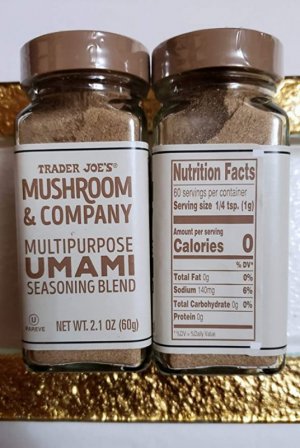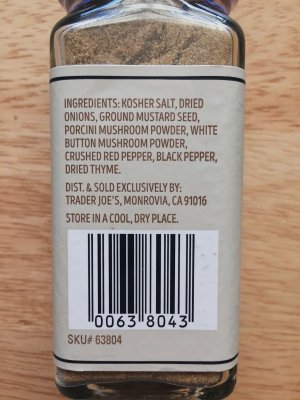Lara
Friend of the Arts
- Location
- Mid-Atlantic Coast
I sprinkle UMAMI Seasoning on my Salmon about once a week before cooking. The ingredients on the bottle does not mention MSG. I looked up what Umami is exactly. Yikes...it said it's MSG! ...and the word "Unami" just describes the savory result of MSG once added to food. SoI further researched.
.............................................
MSG has an image problem. An estimated 42% of us are trying to limit or avoid MSG entirely, according to the International Food Information Council. At the same time, food companies and restaurants love it for its rich, savory flavor. That’s a pretty big disconnect. Is MSG really as problematic as we’ve been led to believe, or is it time to give it a second look?
Every day, the average person consumes roughly 13 grams of natural glutamate from foods like Parmesan cheese, tomatoes, mushrooms, meat, walnuts and asparagus. We also get about half a gram of glutamate a day in the form of MSG that’s added to foods. Is one better or worse for you than the other?
MSG is made by fermenting sugar cane, tapioca or corn, much the same way that yogurt is produced by fermenting milk or vinegar is made from fermented wine. By itself, MSG doesn’t have much flavor. But when it’s incorporated into certain foods it can enhance their meaty taste, an effect known as umami. That’s why you’ll find it in many processed foods, including deli meats, hot dogs, instant noodles, flavored crackers and chips, salad dressings, soy sauce and canned soup. But MSG isn’t just in packaged foods. It’s also added to take-out and restaurant dishes like stir-fries and pasta with meat sauce.
“Although the author said that these symptoms could have stemmed from several things in his food, including sodium, alcohol from the cooking wine or MSG, the public picked up on MSG and dubbed the condition ‘Chinese Restaurant Syndrome,’” said Amidor. Since then, MSG has come under the microscope and things have never been the same. In the past 50 years, anecdotal reports have linked it to a long list of symptoms, including heart palpitations, chest pain, nausea, headache, the sweats and facial flushing, numbness, tingling, pressure and burning.
That doesn’t, however, mean everyone can eat MSG-containing foods problem-free. Research suggests that for a small number of highly sensitive people MSG may trigger the same symptoms listed above. As unpleasant and scary as these reactions may be, medical experts don’t consider them to be dangerous. It can also be helpful to know that they’re generally short-lived, starting about 20 minutes after eating and clearing up within two hours.
On the flip side, there may be an unsung positive for MSG. Because it’s so flavorful, it may actually help food manufacturers reduce the amount of sodium they would normally add to foods. And don’t be misled by the “sodium” in its name. “MSG has two-thirds less sodium compared to table salt,” said Amidor. “So it’s a nice seasoning to use if you’re trying to cut back on sodium, especially since it can increase the depth of a dish by adding umami flavor.”
In the end, if you’re one of those people who is MSG sensitive, it makes sense to avoid it. For everyone else, there’s no need to stress about it.
The Today Show
Nov. 4, 2020
Karen Ansel, M.S., R.D.N.
.............................................
MSG has an image problem. An estimated 42% of us are trying to limit or avoid MSG entirely, according to the International Food Information Council. At the same time, food companies and restaurants love it for its rich, savory flavor. That’s a pretty big disconnect. Is MSG really as problematic as we’ve been led to believe, or is it time to give it a second look?
What exactly is MSG anyway?
MSG, or monosodium glutamate, is a compound made of two naturally occurring substances, sodium and glutamic acid (aka glutamate). You probably already know all about sodium. But what about glutamic acid? Science-y as it might sound, glutamic acid is simply an amino acid, or a building block of protein, that’s found in our bodies. It’s also naturally present in certain foods.Every day, the average person consumes roughly 13 grams of natural glutamate from foods like Parmesan cheese, tomatoes, mushrooms, meat, walnuts and asparagus. We also get about half a gram of glutamate a day in the form of MSG that’s added to foods. Is one better or worse for you than the other?
MSG is made by fermenting sugar cane, tapioca or corn, much the same way that yogurt is produced by fermenting milk or vinegar is made from fermented wine. By itself, MSG doesn’t have much flavor. But when it’s incorporated into certain foods it can enhance their meaty taste, an effect known as umami. That’s why you’ll find it in many processed foods, including deli meats, hot dogs, instant noodles, flavored crackers and chips, salad dressings, soy sauce and canned soup. But MSG isn’t just in packaged foods. It’s also added to take-out and restaurant dishes like stir-fries and pasta with meat sauce.
Why does MSG get such a bad rap?
MSG is hardly new. It’s been used to flavor foods for more than 100 years. And for six decades no one ever had a problem with it. Until 1968. That’s when a doctor reported in a letter to the New England Journal of Medicine that he had experienced palpitations and numbness in his neck, back and arms after eating Chinese food.“Although the author said that these symptoms could have stemmed from several things in his food, including sodium, alcohol from the cooking wine or MSG, the public picked up on MSG and dubbed the condition ‘Chinese Restaurant Syndrome,’” said Amidor. Since then, MSG has come under the microscope and things have never been the same. In the past 50 years, anecdotal reports have linked it to a long list of symptoms, including heart palpitations, chest pain, nausea, headache, the sweats and facial flushing, numbness, tingling, pressure and burning.
Here’s what the latest science says about MSG
Despite the extensive number of symptoms reportedly linked to MSG, the FDA says that MSG is safe. Other health authorities including the World Health Organization, Health Canada and the Federation of American Societies for Experimental Biology agree. What’s more, one recent review study concluded that there is inadequate evidence to support many health concerns surrounding MSG, pointing out that much of the research has used doses of MSG that far exceed what people normally consume.That doesn’t, however, mean everyone can eat MSG-containing foods problem-free. Research suggests that for a small number of highly sensitive people MSG may trigger the same symptoms listed above. As unpleasant and scary as these reactions may be, medical experts don’t consider them to be dangerous. It can also be helpful to know that they’re generally short-lived, starting about 20 minutes after eating and clearing up within two hours.
On the flip side, there may be an unsung positive for MSG. Because it’s so flavorful, it may actually help food manufacturers reduce the amount of sodium they would normally add to foods. And don’t be misled by the “sodium” in its name. “MSG has two-thirds less sodium compared to table salt,” said Amidor. “So it’s a nice seasoning to use if you’re trying to cut back on sodium, especially since it can increase the depth of a dish by adding umami flavor.”
In the end, if you’re one of those people who is MSG sensitive, it makes sense to avoid it. For everyone else, there’s no need to stress about it.
The Today Show
Nov. 4, 2020
Karen Ansel, M.S., R.D.N.



